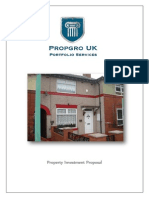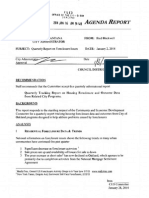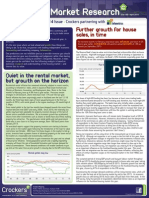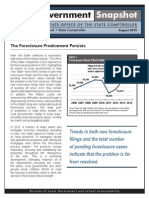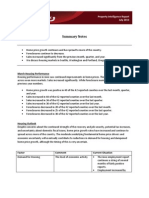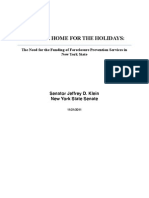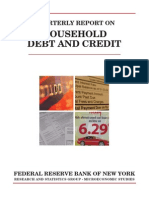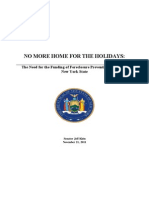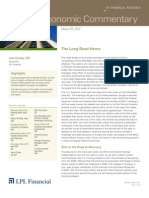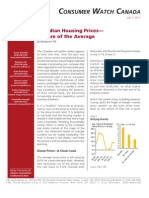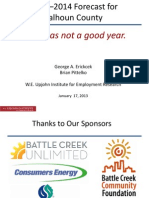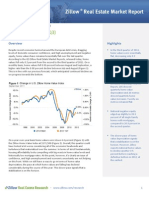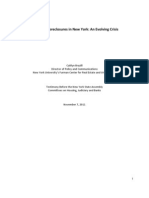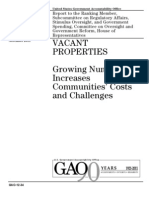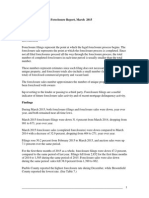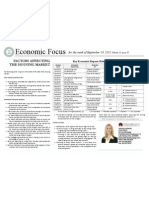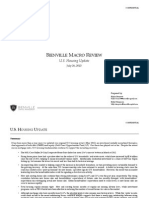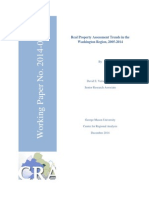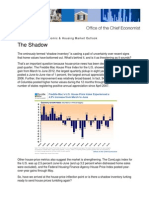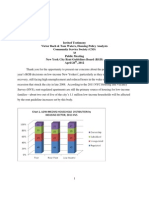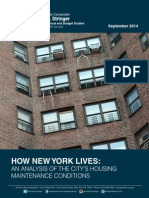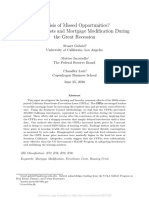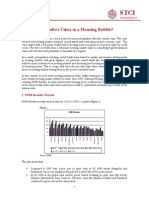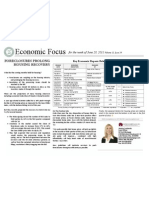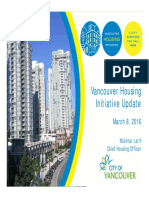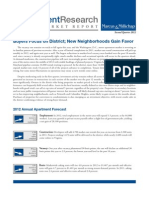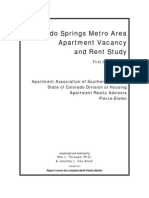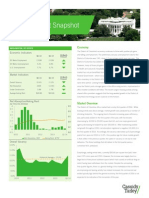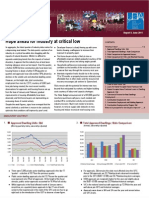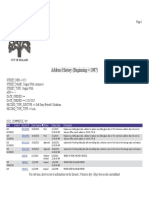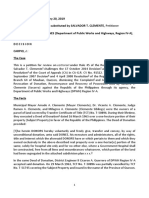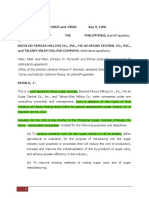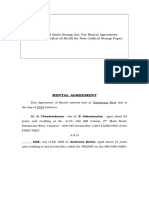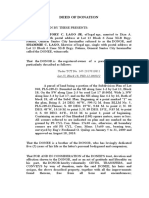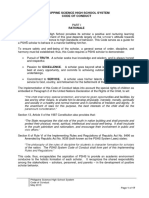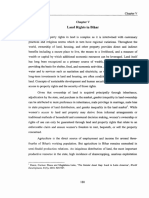4.29.14 CED Report PDF
4.29.14 CED Report PDF
Uploaded by
RecordTrac - City of OaklandCopyright:
Available Formats
4.29.14 CED Report PDF
4.29.14 CED Report PDF
Uploaded by
RecordTrac - City of OaklandOriginal Title
Copyright
Available Formats
Share this document
Did you find this document useful?
Is this content inappropriate?
Copyright:
Available Formats
4.29.14 CED Report PDF
4.29.14 CED Report PDF
Uploaded by
RecordTrac - City of OaklandCopyright:
Available Formats
L FIT
I Mi')
AGENDA
REPORT
F R O M : MicheleByrd
TO: FRED BLACKWELL
CITY ADMINISTRATOR
SUBJECT: Quarterly Report on Foreclosure Issues
City Administrator
Approval
DATE: April 8, 2014
Date
COUNCIL DISTRICT: Citv-wide
RECOMMENDATION
Staff recommends that the Committee accept this quarterly informational report:
Quarterly Tracking Report on Housing Foreclosure and Outcome Data
from Related City Programs.
BACKGROUND
This report responds to the standing request of the Community and Economic Development
Committee for a quarterly report tracking housing foreclosure data and outcomes from City of
Oakland programs designed to help address problems caused by foreclosures.
ANALYSIS
I.
RESIDENTIAL FORECLOSURE DATA & TRENDS
National information on foreclosure issues shows the following trends in many urban
communities, with recovering local economies, have continued this past quarter:
1. Continued significant decline in foreclosure activities.'
2. Sale prices are up and availability of houses for sale is beginning to increase in tight
markets.^
Foreclosure Forecast for 2014 Anticipated Impact on Housmg Market, March 23, 2014, www loanlove com
' Bloomberg News, Home Sellers Return for Spring Market as Buyers Get Relief, February 7, 2014
Item:
CED Committee
Apnl 29, 2014
Fred Blackwell, City Administrator
Subject Quarterly Report on Foreclosure Issues
Date Apnl 8, 2014
Page 2
3. The pnor increase in short sales^ has now declined in Oakland, which appears to be
primanly due to completion activities from the National Mortgage Settlement
Agreement.
4. A slow-down of investors purchasing foreclosed properties in hot housing markets like
Oakland's.'*
National Mortgage Settlement Agreement & Aftermath
Regarding the National Mortgage Settlement Agreement (NMSA) negotiated with five (5) major
banks: Ally, Bank of America, Citibank, JP Morgan Chase, and Wells Fargo, according to the
latest Monitor's report, "there continue to be issues with the loan modification process, single
point of contact, and customer records."^ The Monitor is continuing to assess servicer
performance. Problems with dual tracking still occur, some of which are not covered under the
protections of the new California Homeowner Bill of Rights Act. Many consumers have filed
complaints with the federal Consumer Financial Protection Bureau (CFPB) concerning mortgage
servicing, loan modification and foreclosure activities by servicers.^
In addition to mfonnation from the last quarter's report regarding new settlement agreements
amved at by federal regulators with majorfinancialinstitutions. Credit Suisse Group A G
(CSGN), Switzerland's second-biggest bank, agreed to pay $885 million to settle lawsuits by the
Federal Housing Finance Agency over mortgages sold to Fannie Mae and Freddie Mac.^
Oakland Data
Recent market data reflects the continuing recovery of Oakland's housing market and decline of
foreclosure activities. However, other data and information also demonstrate the impact of
Oakland's escalating housing market on low to moderate income households in terms of housing
affordability, access, and conditions.
A. Foreclosure Activities Continue to Decline From Last Year
Average monthly Notice of Default (NOD) filings are up 19 percent from last quarter, with 84
and 81 filed in January and February respectively. This represents a higher average than 3 out of
the 4 quarters m 2013, but is still 29% lower than the recent peak last Spring.
New York Times, Despite Aid, Borrowers Still Face Foreclosure, 2/21/13
USA Today, As Prices Rise, Rental Home Investors Seek New Markets, January 22, 2013
^ Office of Mortgage Settlement Oversight, Summary of Compliance A Report from the Monitor of the National
Mortgage Settlement Agreement. June 19, 2013
Washington Post, Consumers lodge thousands of complamts against firms that service mortgages, February 4,
2014
^ Bloomberg Business Week, Credit Suisse to Pay $885 Million to Settle U S Mortgage Cases, March, 21, 2014
Item:
CED Committee
Apnl 29, 2014
Fred Blackwell, City Administrator
Subject Quarterly Report on Foreclosure Issues
Date April 8, 2014
Page 3
Oakland NOD Filings
Avg/Mo
Qtr
Period
2012 Q l
Q2
Q3
Q4
2013 Q l
Q2
Q3
Q4
609
613
494
410
224
305
215
211
January 2014
February 2014
Q l 2mo Avg
Change in A v g since last Qtr:
Year-Over-Year: Jan 2013 - Jan
2014
203
204
165
137
75
102
72
70
January 2013:117
84
81
83
+19%
-29%
More information, including foreclosure activities by specific major lenders is available at
Attachment A.
Short sale activity has continued tofluctuateslightiy but with overall decline: average monthly
sales for less than the value owed are down 31%) frorh the last quarter and 52%)'from last year.
However, a greater share of short sales are happening for properties that have not had a
default filed in the last 180 days, up from 68% in the first quarter of 2013 to 84% on
average in January and February of 2014. Re-sales or "flips" of short sale purchases are down
to just a few per month.
Oakland Short Sale Trends
Sifenod
2012 Q l
Q2
Q3
Q4
2013 Q l
Q2
w/NOD in last 180 days
,
Avf\l..
95
120
159
116
73
54
All
Qlr
32
40
53
39
24
18
235
301
342
341
231
260
illAy&^o
78
100
114
114
77
87
Item:
CED Committee
April 29, 2014
Fred Blackwell, City Administrator
Subject Quarterly Report on Foreclosure Issues
Date April 8, 2014
Page 4
Q3-
17
96
32
Q4
24
162
54
2014 January
45
February
11
29
Change from last quarter'
6%
-31%
Change from last year
-65%,
-52%
' 2013 Q3 figuies adjusted down fiom last quartei's lepoit to conect foi data entiy erroi's
Trustee sales havefluctuatedfor the first two months of this quarter around the lows of the
second half of 2013. Investors continue to be less active at auction, a trend that began last Spnng.
About 47%) of auctioned properties became bank owned in January and February of 2014,
equating to 14 homes per month on average
.^ftimmiii,',,..
Auction Outcomes
;A11;Auctions ,4
ilridd''-^*' Isift
^Avg/Mo
(;)lr
., Auction to
^#R
;EO/
2012 Q l
405
135
Q2
278
93
62%
Q3
Q4
266
89
57%
231
77
60%
TOTAL 2012
2013 Q l
1180
98
63%
161
54
55%
Q2
151
50
26%
Q3
103
34
38%
Q4
105
35
40%
TOTAL 2013
520
71%
43
40%
2014January
36
50%
February
21
43%
29
47%
TOTAL 2013 Year to Date
57
B. Housing Market Prices Continue to Escalate While Sales Continue to Decline
With Implications for Income Inequality
Following state-wide trends, residential property sales in Oakland this quarter are down sharply
from the peaks seen in the spring and fall of 2013: down 49% from last quarter and 37% from
last year. Non-distressed market sales have seen the sharpest declines, down by 54% from last
quarter and 35%) from last year. Distressed sales including short sales, foreclosure auctions, and
Item:
CED Committee
April 29, 2014
Fred Blackwell, City Administrator
Subject Quarterly Report on Foreclosure Issues
Date April 8, 2014
Page 5
salesfromREO have tapered off at a slightly slower rate this quarter, dropping 41% from last
quarter.
Oakland Sales Trends
293
265
135
107
Non-Market/
Distressed Sales
^^^^^^
228
685
287
861
249
748
688
229
533
178
,173
518
494
165
616
205
149
65
Reg.Market
Sales
$i
PtTliid
2012 Q l
Q2
Q3
Q4
2013 Q l
Q2
Q3
Q4
2014 January
February
280
514
554
668
556
885
879
796
93
171
185
223
185
295
All Sa es
.fe>t#rMi?-4 jiAy^glM^
965
1375
1302
1356
1089
1403
1373
1413
322
458
434
452
363
468
458
471
284
172
Average/Mo
Change from last Qtr
121
107
-54%,
-41%,
228
-49%
Change from last year'
-35%.
-4oyo
-37%,
Oakland's housing pnces continue to skyrocket and Oakland is considered to be one of the
nation's fastest-moving housing markets.^ According to realtor.com, Oakland's current median
listing price of $475,000 increased $7,500 from last quarter's median listing price and reflects an
increase of 18.6%fromlast year's prices.^
In addition, Oakland's foreclosure cnsis, which led to home loss for 1 in 14 Oakland households
and then to subsequent investor purchases, has contnbuted to dramatically rising rents. In the
prior quarter, as compared to 2012, reports show that Oakland saw a 15% increase in rents across
apartment buildings and a 10.3%, rent increase in buildings of 50 units or more.' These increases
were in addition to the 11.5% increase in rents from 2011 to 2012.
The high cost of housing may also be a contributing factor in Oakland's existing income
inequality by discouraging low to moderate income households from moving into or pushing
http //www homebuyinginstitute com/news/homes-selling-faster-440/
^ http //www realtor com/data-portal/Real-Estate-Statistics aspx
' San Francisco Chronicle, "Rents Soanng Across Region," October 25, 2013 (10 3% increase from 2012 for
buildings over 50 units from source RealFacts, 15%) increase across all apt buildingsfromsource Lovely)
Item:
CED Committee
April 29, 2014
Fred Blackwell, City Administrator
Subject Quarterly Report on Foreclosure Issues
Date Apnl 8, 2014
Page 6
existing households out of Oakland. In a recent Brookings Institution study, Oakland was ranked
the 7* city in the nation for the highest income inequality.'' The income inequality analysis was
based upon the distance between households at the top 5% by income and ones at the bottom
20%). In Oakland, households at the lowest 20%) income earn $17,646 while those at the highest
5%) income earn $223,965 for a ratio difference of 12.7. Incomes for both the 20% lowest and
5% highest income households declined from 2007 to 2012, which resulted in no change in the
12
income inequality gap between those years.
C. Recent Reports Show Demographic Shifts, Displacement Risks, and Housing
Habitability Concerns
As reported in pnor quarters, the profile of current Oakland homeowners in foreclosure crisis has
changed dramatically in the past several years. Currently, 90%) of Oakland families in
foreclosure have owned their home for at least 6 years, with over one-third of them owning their
homes for more than 10 years. Many of the families City staff are assisting have owned their
homes for decades, including over 50 years, or residing in family legacy homes passed down
through multiple generations
As discussed in prior reports, the dynamics of Oakland's foreclosure crisis have significantly
contributed to the current problems of housing access and affordability for many long-time
residents, both homeowners and tenants. Alameda County Public Health Department, in a recent
report with Causa Justa::Just Cause, recently released new demographic data,''' including the
following:
Oakland neighborhoods experiencing or at significant nsk of displacement include North
Oakland, San Antonio and West Oakland. Chinatown, Fruitvale, Central East Oakland
and Elmhurst are experiencing increasing property values and susceptibility to
displacement forces
Between 1990 and 2011, the median monthly rent m late-stage gentnfying neighborhoods
increased by $280, or 30%o, and areas experiencing ongoing gentnfication saw the largest
increase in median housing values (a $274,760 increase).
Between 1990 and 2011, the percentage of Oakland residents who are African Amencan
decreased from 43%, to 26%, the largest drop by far across any group. During this same
Brookings Institution, Alan Berube, All Cities Are Not Created Unequal, February 20, 2014 The top 6 cities for
income inequality were, by ranking order, Atlanta, San Francisco, Miami, Boston, Washington DC, and New York
Income for the 20% lowest income declined by $ 1,062 and for the 5* highest income declined by $ 14,059 Id.
"Gentrification, Displacement and Public Health Why Neighborhood Change Matters for Health in Oakland"
Fact Sheet, Alameda County Public Health Dept and Causa Justa Just Cause, March 18, 2014
Item:
CED Committee
- April 29, 2014
Fred Blackwell, City Administrator
Subject Quarterly Report on Foreclosure Issues
Date April 8, 2014
Page 7
period, the percentage of homeowners in North Oakland who are African American
dropped from nearly 50% to 25%.
The increased housing costs and demographic character shifts associated with
gentnfication may exacerbate the following conditions:
'
o rent burden and overcrowding;
o the closure of vital community institutions and health and social services;
o existing social and health inequities withm neighborhoods,
o the eviction rate for low-income tenants; and
o homelessness resultingfromthe above impacts.
Displacement of residents from their homes and neighborhoods increases:
o financial hardship due to relocation costs, loss of assets, and increased
transportation costs resultingfromlonger commutes;
o disruptions to employment and income and decreased educational performance;
o psychological distress;
o disruption to routine medical care;
o the migration of Afiican Amencan households to higher poverty neighborhoods;
and
o communityfragmentationand social network disruption, resulting m increased
health problems and intra-community violence.
Displacement widens income inequality and increases segregation, while also increasing
greenhouse gas emissions that result from longer commutes.
At the same time many residents are experiencing displacement nsks, significant areas of
Oakland have serious housing habitability problems. A recent report by Urban Strategies
Council, prepared for the Alameda County Healthy Homes Alliance, found the following:''*
In over two-thirds of Oakland census tracts, at least 90% of the housing stock was built
before 1979 and poses a potential risk of lead paint hazards that are highly toxic for
developing children.
Forty-six percent of both renters and owners spend 35% or more of their household
income for housing. To afford a two-bedroom apartment at the fair market rent of
$1,361, a renter household would need an annual income of $54,440, which translates to
3.27 full time minimum wage jobs or 1.9 full time living wage jobs.
A lack of affordable housing is linked to diminished capacity to pay for childcare, health
insurance, and healthy, nutntious food. The health impacts of these trade-offs include
increased hypertension, stress and household instability.
'"^ "Building an Indicator Base for Healthy Housmg Issues m Oakland," prepared for the Alameda County Healthy
Homes Alliance by Urban Strategies Council, November 2013
Item:
CED Committee
Apnl 29, 2014
Fred Blackwell, City Administrator
Subject Quarterly Report on Foreclosure Issues
Date April 8, 2014
II.
Page 8
81%) of vacant homes in Oakland, 3,620, have been vacant for at least 3 years. Vacant
homes are most highly concentrated in West Oakland, where 7%) to 15% of homes were
vacant as of June 2013.
Foreclosed homes sitting vacant have an increased prevalence of mold growth due to
poor ventilation and lack or required maintenance. Vacancyfiartherstrains municipal
services through increased crime, toxic dumping and vandalism, which negatively impact
public safety and neighborhood stability, while depressing property values of neighboring
homes.
From 2003 to 2013, the City's Building Services Division received over 32,500
complaints regarding occupied blight (interior habitability issues and structural defects),
over 8,500 complaints for extenor blight, and nearly 7,000 complaints for work without a
permit.
Areas with the largest numbers'of occupied blight complaints are nearly all in the City's ,
low to moderate incomeflatlandneighborhoods. In the neighborhoods of Longfellow,
Hoover/Foster, the San Antonio, Fruitvale, Lower Maxwell Park and Havenscourt, as
many as 6 out of 10 households filed a code enforcement complaint regarding habitability
or structural defects between 2003 and 2013.
FORECLOSURE PREVENTION & MITIGATION PROGRAM STATUS
On October 16, 2012, Council approved fiinds for new and expanded activities to prevent and
mitigate foreclosures, including the following:
Direct outreach to homeowners with a NOD and tenants living in NOD properties.
Hotline services for tenants and homeowners in distress to connect to appropnate
services.
Housing counseling and legal services.
City escalation team to work with Bank escalation teams.
ROOT loan fund program to preserve homeownership for qualified distressed families.
Reporting of violations of National Mortgage Settlement Agreement or the new State
Homeowner Bill of Rights Act to the State Monitor or Attorney General's office.
In the first year of the foreclosure prevention and mitigation initiative: outreach workers made
over 4,000 attempts and ultimately reached nearly 800 homeowners and tenants occupying NOD
and REO homes to provide information about available resources; over 350 homeowners
received housmg counseling or legal services to prevent or mitigate foreclosure; and over 200
tenants in properties affected by default and foreclosure received tenant counseling or legal
services. These efforts kept over 90 homeowner households and over 50 tenant households in
their homes, and provided alternative housing solutions for 23 other families.
Item:
CED Committee
Apnl 29, 2014
Fred Blackwell, City Administrator
Subject Quarterly Report on Foreclosure Issues
Date Aprils, 2014
Page 9
In the first two months of 2014, intenm outreach efforts to NOD properties have reached 19
tenants, 24 homeowners, and connected an additional 4 homeowners with foreclosure sale dates
to legal services. Starting this month, outreach workers will go'door-to-door in Oakland
neighborhoods that have been impacted by the foreclosure crisis and escalating housing costs to
inform homeowners and tenants about housing rights and resources, in addition to foreclosurerelated assistance. Also in the first two months of 2014, over 84 homeowners have accessed
legal services, including 10 that have successfully obtained loan modifications, and 6 tenants
have received assistance with foreclosure-related housmg issues, including eviction prevention.
For more details about performance outcomes, see Attachment B.
The ROOT Loan Fund Program
Funded by the remainder of the City's federal Neighborhood Stabilization Program fiinds,
$650,000, the ROOT program was a 12-18 months pilot program to better understand the
specific challenges involved in secunng homeownership for qualified current or former
distressed homeowners. The following are highlights of lessons learned from the pilot
experience:
Through the City's intervention and initial partnership by Wells Fargo, major lenders
were willing to participate in the ROOT program.'^ This was a major hurdle that
prevented the effectiveness of similar attempts in other jurisdictions that the City and its
partners were able to overcome. For example. Bank of Amenca had agreed to waive its
internal policy prohibiting a short sale if it resulted in the home going back to the onginal
owner in order to work with the City on the ROOT pilot
The process involved in assisting individual homeowners is very cumbersome and timeconsuming, and yet invaluable in helping elderly and long-time residents preserve their
homes. The ROOT model serves homeowners who could sustain mortgage payments if
they were re-set to market or subsidized value and have challenges that traditional loss
mitigation processes are not able to resolve, such as a completed foreclosure, inflated
market value of their home, or failure to meet loss mitigation guidelines. The ROOT
nonprofit administrator, Community Housing Development Corp (CHDC), reviewed 25
Oakland households for the ROOT program with the following results* 3 passed
underwriting review and successfully kept their homes; 7 had insufficient income or were
in active bankruptcy; 5 received a loan modification or other alternative housing solution
through other City partnership efforts; 4 did not have a current hardship; 3 withdrew from
consideration; 2 had banks such as Freddie Mac that couldn't participate; and I is a
pending case.
15
The exceptions were Fannie Mae and Freddie Mac due to the Federal Housing Finance Agency's administrative
policy prohibiting principal reduction
Item:
CED Committee
Apnl 29, 2014
Fred Blackwell, City Administrator
Subject Quarterly Report on Foreclosure Issues
Date April 8,2014
Page 10
The ROOT pilot program, with the available NSP funds, was able to assist three Oakland
homeowners preserve their homes, including one who recently lost her home to
foreclosure as a result of a predatory transaction. All three homeowners owned their
homes for decades, and are senior citizens, community leaders and stabilizing forces in
their neighborhoods. All three homeowners are also Afiican Amencan and reside in
neighborhoods that were histonc bastions of Afiican Amencan homeownership. While
the public subsidy involved in the original transactions was significant, the community
benefits to assisting these homeowners include public health and safety outcomes. In
addition, once their loans season and are able to be sold in the secondary market, the
funds will recycle and be able to assist additional families.
With the escalating market value of Oakland's homes especially m areas that used to
have high rates of African American homeownership, the City needs foreclosure
prevention strategies that address the gap between affordability and market value, such as
the new flexible Home Preservation Loan Fund that the City and its partners recentiy
created.
Another significant outcome of the ROOT pilot has been changing the prevailing
nonprofit development model which was based upon the acquisition of vacant foreclosed
properties, rehabilitation, and re-sell to new homeowners. Single family property
nonprofit developers, such as Hello Housing, Self Help, Habitat for Humanity, and the
Oakland Community Land Trust, are now open to considering purchasing occupied
foreclosed properties as a way to preserve those families in their homes.
In a post-NSP fimding landscape, the City is working with its partners to develop new home
preservation tools. We are currently working with Hello Housing and Self Help to assist two
long-time Oakland families who both recently lost their homes to foreclosure as a way to pilot
new strategies.
Jobs for Oakland Residents
In addition to staff currently employed with thefiandedorganizations, the outreach orgamzations
employed eight employees to conduct street outreach on a part-time basis, all of whom are
Oakland residents.
National Learning Community
There is continuing interest from other communities regarding the City's foreclosure prevention
and mitigation plan and staff has provided information and/or assistance to the following
communities this quarter: Seattle, Chicago, and Brockton, Massachusetts, as well as presented
Oakland's programs at convenings organized by the San Francisco Federal Reserve and HOPE
Now, and Harvard Law School's Legal Aid Bureau.
Item:
CED Committee
Apnl 29, 2014
Fred Blackwell, City Administrator
Subject Quarterly Report on Foreclosure Issues
Date April 8, 2014
Page 11
Addressing Critical GapsNew Home Preservation and Anti-Displacement Efforts
As discussed in prior reports, staff has been working with the National Fair Housing Alliance
(NFHA) and local organizations to address the new challenges that Oakland homeowners and
renters currently face. The following is an update of the new resources and efforts.
Homeownership Preservation Loan Fund: The Unity Council has agreed to administer the
new fiind that would provide grants up to $50,000 per household for families who need gap
fiinds as part of a home preservation strategy. The new Fund started last month and has helped
one Oakland household in distress keep her home with several other families in the application
process.
Tenant Anti-DisplacementThe Pay It Forward Fund: Catholic Charities has agreed to
administer the new $250,000 dedicated to provide rental housing assistance grants of up to
$5,000 per household for tenant families being pushed out of their rental housing. The grant
agreement between Catholic Charities and NFHA is pending.
Community Buying ProgramTransforming Abandoned Properties into New Affordable
Housing with Minimal Public Subsidy: Hello Housing, the City's selected nonprofit
administrator, working with City staff, has secured pnority buying commitments from Fannie
Mae, Wells Fargo, and the National Community Stabilization Trust. Implementation details are
being worked on as part of these new pilot efforts. There are currently three pending offers to
Wells Fargo and Fannie Mae. In addition, coordination between Hello Housing is occumng with
City Code Enforcement staff to pnontize disposition strategies for properties with code
enforcement problems.
We are also working on the development of disposition strategies for 53 abandoned properties
that did not sell in the pnor pilot auction program that the City and County had developed. The
goal IS to transform these abandoned properties, mainly vacant lots, into new affordable
ownership or rental housing and for the lots that are not buildable into community gardens or
other public benefit use. To facilitate achieving these goals, we may need to return to Council
with requests that may include the following:
16
The City Council resolution approving the pilot auction program resolves "that the
Council approves the removal of City liens from the 75 properties identified in Exhibit A,
should the property be sold at auction, for purposes of facilitating the purchase and active
reuse of these properties in the county Auction program."'^ We may need to seek
Council clarification that the "auction process" contemplated by Council includes the
disposition of properties that did not sell in the formal auction but are available for
municipal governmental and nonprofit disposition post-auction as provided by State
guidelines.
Council Resolution No 84057 C M S , October 2, 2012
Item:
CED Committee
April 29, 2014
Fred Blackwell, City Administrator
Subject Quarterly Report on Foreclosure Issues
Date April 8, 2014
^
Page 12
The Council resolution further resolves that "City proceeds from the County auction
program would be allocated towards repayment of the Development Services Fund 2415
negative fiind balance." The sale of 22 properties m the pilot program has resulted in the
payment of $1,187,822.24 to the City. The City's hard costs incurred on the original
pilot 75 properties was $1.3 million over a period of up to 15 years and the City had
classified these as costs unlikely to be recovered. Staff proposes that proceeds from any
new sale of the remaining 53 properties to community buyers be set aside to subsidize
rental housing for households earning below 80%) of Area Median Income.
Bigger Scale Prevention Efforts
Like other communities around the nation hard hit by the foreclosure cnsis, the City of Oakland
has been attempting to develop bigger scale prevention solutions beyond the labor-intensive
individual by individual homeownership preservation strategies. As discussed in prior reports,
the City has been working with national, state, and local groups on the development of a possible
distressed mortgage notes sale program. As expenenced by pnor efforts,'^ there are significant
challenges to the effectiveness of such programs, including the following:
The willingness or current ability of lenders to sell distressed mortgage notes that are
disaggregated by locality rather than bundled into larger geographies.
The relatively low numbers of homeowners m distress who could sustain new mortgage
payments even with a re-setting of mortgage to market value and some subsidy assistance
from the new Oakland Homeownership Preservation fiind.
Effective alternative disposition strategies for the families who cannot sustain
homeownership and for properties which are vacant.
Thefinancialviability and sustainability of operating the programs.
Staff is engaging in due diligence regarding a possible pilot program utilizing HUD loans in
Oakland and possible partnership with the State and their federallyfiindedKeep Your Home
California resources.
For example, staff conducted due diligence on the efforts of the Mortgage Resolution Fund, a national partnership
to assist homeowners in Illinois and Ohio through the purchase of mortgage notes
http //mortgageresolutionfiind org/
Item:
CED Committee
Apnl 29, 2014
Fred Blackwell, City Administrator
Subject Quarterly Report on Foreclosure Issues
Date April 8, 2014
III.
Page 13
FORECLOSED PROPERTIES PROGRAM STATUS
The following is a quarterly and year-to-date summary of performance outcomes from the City's
Foreclosed and Defaulted Properties Registration, Inspection, and Maintenance Programs.
Specific information, including performance by major lenders is provided m Attachment A.
Time Period
Registrations
Properties Inspected
Q. 1/1/2014
3/30/2014
316
112
YTD 7/1/2013
3/31/14
971
348
Charges Directly
Collected
$192,962 total
$60,391 regfees'^
$132,570 penalties
$958,514 total
$143,058 regfees''^
$815,455 penalties
Proactive inspections of 101 foreclosed and defaulted properties this quarter found only one case
of minor blight at a bank-owned property and 2 cases of minor blight at properties in default. The
defaulted cases show no signs of abandonment and the owner was notified of the violations and
given 30 days to abate. In addition, 11 properties were inspected this quarter to follow up with
new complaints regarding blighted defaulted or foreclosed properties. Four of these complaints
were verified and abated timely, 8 are in the abatement period, and one case resulted in penalties
for untimely abatement but is now clean and secure. Information in Attachment A provides
violations numbers for specific lenders/servicers.
Staff continues to deal with unauthorized occupants and associated blight and nuisance activity
in abandoned and/or defaulted or foreclosed properties, but successful coordination with the
police department and'lender contracted maintenance companies over the past several quarters
has reduced the number of active cases. Four successful cleanups were completed by lender
contractors this quarter with OPD standby assistance and one is pending. Properties with a
history of break-ins are monitored regularly.
IV.
STATUS OF INVESTOR OWNED FORECLOSED AND DEFAULTED PROPERTIES PROGRAM
In November 2012, the City Council passed an ordinance requinng the registration, inspection,
and maintenance of formerly foreclosed or defaulted properties purchased by investors. The new
program, including a new online registration portal, launched in early August 2013. Registration
notices were issued to 85 properties between August 2013 and March 2014. The following is a
summary of program status"
An additional $8,905 in Rec/Tech restncted fees were collected
' An additional $21,094 in Rec/Tech restricted fees were collected
Item:
CED Committee
April 29, 2014
Fred Blackwell, City Administrator
Subject Quarterly Report on Foreclosure Issues
Date April 8, 2014
Page 14
42 properties have registered.
9 new registrations are pending.
19 properties were determined to be exempt.
26 penalties have been assessed for failure to register.
4 cases have been closed with no violations and another 4 with timely abatement.
21 cases have incomplete registrations and pending inspections.
15 registered properties have abatement in progress.
37 new notices to register are pending.
Of the 24 inspections conducted so far, 20 properties were issued a Notice of Violation and given
30 to 60 days to abate the conditions. Fifteen inspections are pending
V.
D E V E L O P M E N T OF PROACTIVE PROGRAMS AND POLICY RECOMMENDATIONS
As provided in past reports, staff has been working with community partners and national
experts to develop new strategies and identify new resources and/or policies to address the City's
current housing challenges in the aftermath of the foreclosure crisis. The City has asked Urban
Strategies Council and Policy Link, funded by N F H A , to work with us to develop a long-term
housing plan, the Oakland Housing Equity Roadmap, to identify possible new policy, program,
or revenue strategies to address the following:
1.
2.
3.
4.
Production of new affordable housing units.
Preservation of existing affordable subsidized and non-subsidized housing stock.
Improving habitability conditions of existing housing.
Transforming abandoned properties mto new housing opportunities, especially long-term
affordable housing.
5. Development of viable incentives and other strategies for pnvate real estate community
participation
Staff has or will be meeting with different stakeholder groups, includmg the following- ACCE,
Alameda County Public Health Department, CJJC, East Bay Rental Housing Association, Jobs and
Housing Coalition, OCO, Oakland Realtors Association, East Bay Housing Organization, and others.
We anticipate the completion of the Oakland Housing Equity Roadmap by the end of June 2014, in time
for the next quarterly report
SUSTAINABLE OPPORTUNITIES
Economic: Oakland's foreclosure crisis has had devastating economic impact to residents,
neighborhoods, economic development efforts, and City revenues. Blighted foreclosed or
defaulted properties have resulted in significant expenditures of limited City resources including
Item:
CED Committee
April 29, 2014
Fred Blackwell, City Administrator
Subject Quarterly Report on Foreclosure Issues
Date April 8, 2014
Page 15
Code Enforcement, Police, Fire, and City Attorney. The City's proactive strategies will foster
Oakland's economic goals.
Environment: Vacant or unmaintained foreclosed or defaulted properties have impacted the
City's physical environment, as well as the health of residents. The City's proactive strategies
will foster Oakland's environmental goals.
Social Equity: The foreclosure crisis has disproportionately impacted lower income residents
who reside inflatlandneighborhoods. The cnsis has also significantly contributed to the current
affordable housing cnsis. The City's proactive strategies will foster social equity goals.
For questions regarding this report, please contact Margaretta Lin, Departments of Housing and
Community Development and Planning and Building, at 510-238-6314.
Respectfially submitted.
Michele Byrd
Director of Housing and Community
Development Department
Reviewed by
Rachel Flynn
Director of Planning and Building Department
Deborah Sandercock
Building Services Division
Attachment A: Foreclosure Data
& Properties Status
Attachment B: Foreclosure
Prevention Performance
Outcomes
Prepared by
Margaretta Lin
Strategic Initiatives Manager
Departments of Housing and Community Development
and Planning and Building
Item:
CED Committee
Apnl 29, 2014
ATTACHMENT A Foreclosure Data and Programs
Notice of Default
NOD/REO Filings
Time Period
Bank*
Current Q t r / J a n ^l\/lar 201'4
Major
Lenders
^,
BofA
Chase
Fannie M a e
Occupied
f'
>.^2 M
2
other
Lenders
- mo f f
Ocwen
32
Bank of NY
i l l If T l
7
One West
others"*
Total
i;
ll
" - -
Lenders
BofA
Chase
Fannie M a e
Wells
Other
Lenders
Ocwen
Nationstar
Bank of NY
Deutsche Bk
One W e s t
SP Servicing
Wofes on
'
43
K'-
-1
0 '
^Si-
''Si'.'-o
13
- ' M o 1 \t|-
) y~m-
1
' ^ ^ , /
0
'1 M
*f--o
'Wt: -3
0
X,
-To
Rr-,
? tt."!
' 1 2
:t5ilJ,4
0
...
fi
."'litil lAij..-o
f f ; 0 M'
2-
- 0
wmz', 0
10
41
35
37
22
270
255
15
46
25
21
101
11
11
12
NOD
mm
12
Freddie M a c
US Bank
55
IS
Notice of Default
ri9
50
i t r 9 4 ."Wf'SO
'16
3
4
4
42
0
1/
4:^317
153
148
19
30
msio
1
4
. [0 l o
'
16
1
0
Li.
0
^Mfi'.lO r x-#7 M M '
S'f*46 1 4 'is I'-Ms fS-f59 1 5 6 " -13
M 19 ii^f f2 i '. 2
26
~T
26
;'l^^x43
i''-
,\ il
'4. . i 3 i5-l-i2 my-
:,;7 g ; ' "
Violations**
Inspected
Timely
Penalties
Violations
' c-
1"
M'24 *i'o t329
5
15
Total
Pending
Violations
Inspected
m
34
49
New Complaints
Vacant
Occupied
REO
4
33
Proactive
Vacant
Occupied
NOD
Abatement
Inspected Properties
Foreclosed / REO
Total
REO
Sale
^Inspections
Ministrations
Total
Trustee
23
,
.31
1.
- : ' -SoM-'--
- -m
i
0
Penalties
Timely
Violations
m -m*
Violations**
167
F?fjb:g4tr*JuJvr:20L3lMa'i?2014;A
Major
/>'0
32
NOD/REO Filings
Bank*
0 ''
'
} c e-
vf'7" - 0
0
'
t^Mi
2 M,
0
Inspected
}
"1
. ~
Violations
16
Mf
3
fto
0
/,
l^f F o r e c l o ' s u r e ' E v e n t ^
Time Period
5 11,1
25
---1 '
29
Mf*Ml4 mi%
Deutsche Bk
1 1 77
0
0
16
Nationstar
3
5
SP Servicing
o
9
S
0
ilS: "0
58
Total
Pending
Inspected
Abatement
New Complaints
Vacant
Itif
Freddie M a c
US Bank
Occupied
REO
;#f 1.- t 4 #
i1
Wells
Vacant
NOD
5* 1
Proactive
Total
REO
Sale
;>1;
Irispcctions
Inspected Properties
Foreclosed/REO
Total
Trustee
NOD
V-Registrationsl
iilfpfeclosure E v e n t s ^
m.
5
''=''0
to
/ ''X
99
' '2'-112
44
2
8
ll
'6
-7
. 1W/'
''S^-' f o
^3 PMI-"-3
13
11
2 8*T;.
^ 27
.'/^MO
.2
m 2
N4
s mi;
0
;
2
' :
V * .
>0
Others***
195
77
23
105
88
17
16
11
29
Total
606
177
80
862
789
73
109
49
60
315
12
33
33
45
17
23
Methodology
*There are often multiple entities involved in the loan for a defaulted or foreclosed property, including the lender or investor/note holder and the servicer that manages the loan payments Properties are assigned to the primary responsible party
based on a combination of information pulled from public records and details provided in the registry
**Proactive inspections this quarter found 3 blighted bank-ownd properties and 5 blighted properties in the default stage, m t h mostly minor violations Only 1 of the defaulted properties is included in the table above because the lender is being
pursued for abatement due to potential abandonment by the owner
* * * In the case of Trustee Sales, this number includes sales to a 3rd party as w/ell as lenders not uniquely identified above
Attachment B: Foreclosure Prevention Service Outcomes, Jan-Feb 2014
Status
Outreach
(OCCUR JanFeb)
Homeowner
Inquiries
(HAC JanFeb)
Homeowner
Legal Services
(HERA NovFeb)
Tenant
Hotline
(CJJC JanFeb)
Tenant
Counseling
(CJJC JanFeb)
HHs
Reached
or Served
250 attempts
47 reached
13
84
Outcomes
19 tenants
referred to
services
24 homeowners
referred to
services
4 clients with
sales dates
referred directly
to HERA
13 referred to
HERA
10 loan mod
completed
1 other help
keepmg home
28 loan mods
or help to save
home pending
40 brief legal
service or
counseling
5 referred to
ROOT or
Homeowner
Rescue Fund
2 Case
management
2 Pending
1 Referred to
Legal
Services
Tenant Legal
Services
(Centro Legal
& E B C L C JanFeb)
Total 3
2 EBCLC
1 Centro
EBCLC
2 Pending
Centro
1 Stopped
Eviction
You might also like
- Property Investment Proposal Web Example 1Document4 pagesProperty Investment Proposal Web Example 1api-61001787No ratings yet
- JurisprudenceDocument16 pagesJurisprudenceSandeep Chawda100% (1)
- Tenancy Agreement NewDocument4 pagesTenancy Agreement NewKingsley MNo ratings yet
- CED Report 1.28.14 PDFDocument16 pagesCED Report 1.28.14 PDFRecordTrac - City of OaklandNo ratings yet
- 9.16.14 FP Quarterly Report PDFDocument15 pages9.16.14 FP Quarterly Report PDFRecordTrac - City of OaklandNo ratings yet
- 7.23.13 CED Report PDFDocument12 pages7.23.13 CED Report PDFRecordTrac - City of OaklandNo ratings yet
- Crockers Market Research: Further Growth For House Sales, in TimeDocument2 pagesCrockers Market Research: Further Growth For House Sales, in Timepathanfor786No ratings yet
- 2015 - 2ndQ Foreclosure ReportDocument17 pages2015 - 2ndQ Foreclosure ReportRyan McMakenNo ratings yet
- 2015 - 3rdQ Foreclosure ReportDocument17 pages2015 - 3rdQ Foreclosure ReportRyan McMakenNo ratings yet
- Foreclosure0815 PDFDocument8 pagesForeclosure0815 PDFNick ReismanNo ratings yet
- Property Intelligence Report July 2013Document4 pagesProperty Intelligence Report July 2013thomascruseNo ratings yet
- The Reader: 2008 Housing and Vacancy Survey Data Released - Affordable Housing Remains ScarceDocument12 pagesThe Reader: 2008 Housing and Vacancy Survey Data Released - Affordable Housing Remains ScarceanhdincNo ratings yet
- October 10 To October 24, 2014: As Recovery Continues, Maryland Households Fall BehindDocument3 pagesOctober 10 To October 24, 2014: As Recovery Continues, Maryland Households Fall BehindAnonymous Feglbx5No ratings yet
- Foreclosure 11211Document8 pagesForeclosure 11211Nick ReismanNo ratings yet
- Household Debt and Credit: Quarterly Report OnDocument31 pagesHousehold Debt and Credit: Quarterly Report OnDavid4564654No ratings yet
- Foreclosure Funding Report Final - 0Document7 pagesForeclosure Funding Report Final - 0Celeste KatzNo ratings yet
- Weekly Economic Commentary 3-26-12Document6 pagesWeekly Economic Commentary 3-26-12monarchadvisorygroupNo ratings yet
- Weekly Economic Commentary 3-26-12Document11 pagesWeekly Economic Commentary 3-26-12monarchadvisorygroupNo ratings yet
- Onsumer Atch Anada: Canadian Housing Prices - Beware of The AverageDocument4 pagesOnsumer Atch Anada: Canadian Housing Prices - Beware of The AverageSteve LadurantayeNo ratings yet
- 2016 Commercial Lending Trends SurveyDocument31 pages2016 Commercial Lending Trends SurveyNational Association of REALTORS®No ratings yet
- CMHC 2015 Northern Housing ReportDocument13 pagesCMHC 2015 Northern Housing ReportAqukkasukNo ratings yet
- Weekly Economic & Financial CommentaryDocument9 pagesWeekly Economic & Financial CommentaryChristophe ChooNo ratings yet
- Calhoun County 2013-14 Economic ForecastDocument56 pagesCalhoun County 2013-14 Economic ForecastBCEnquirerNo ratings yet
- Zillow Q3 Real Estate ReportDocument4 pagesZillow Q3 Real Estate ReportLani RosalesNo ratings yet
- Mortgage Foreclosures in New York Testimony Before The New York State AssemblyDocument9 pagesMortgage Foreclosures in New York Testimony Before The New York State AssemblyCaesar NguyenNo ratings yet
- Merrimack Valley Housing Report April 2015Document4 pagesMerrimack Valley Housing Report April 2015M CurtissNo ratings yet
- CBRE Los Angeles Retail Marketview Q1 2014Document5 pagesCBRE Los Angeles Retail Marketview Q1 2014Robert AbelsonNo ratings yet
- ANZ Greater China Weekly Insight 2 April 2013Document13 pagesANZ Greater China Weekly Insight 2 April 2013leithvanonselenNo ratings yet
- Household Debt and Credit: Quarterly Report OnDocument33 pagesHousehold Debt and Credit: Quarterly Report OnTBP_Think_TankNo ratings yet
- GAO ReportDocument102 pagesGAO ReportForeclosure FraudNo ratings yet
- Fiscal Policy, Politics and Weather Patterns... : Julie WillisDocument4 pagesFiscal Policy, Politics and Weather Patterns... : Julie WillisJulie Crismond WillisNo ratings yet
- Household Debt and Credit: Quarterly Report OnDocument30 pagesHousehold Debt and Credit: Quarterly Report OnDinSFLANo ratings yet
- Household Debt and Credit: Quarterly Report OnDocument31 pagesHousehold Debt and Credit: Quarterly Report OnZerohedgeNo ratings yet
- Commercial Real Estate Outlook August 2013Document9 pagesCommercial Real Estate Outlook August 2013National Association of REALTORS®No ratings yet
- PWC Housing MarketDocument11 pagesPWC Housing MarketAndrew KingNo ratings yet
- Michaels Title September NewsletterDocument7 pagesMichaels Title September NewsletterMichaelstitleNo ratings yet
- 2010 0113 EconomicDataDocument11 pages2010 0113 EconomicDataArikKanasNo ratings yet
- Monthly Foreclosure Report - March2015Document10 pagesMonthly Foreclosure Report - March2015Ryan McMakenNo ratings yet
- Economic Focus 9-19-11Document1 pageEconomic Focus 9-19-11Jessica Kister-LombardoNo ratings yet
- Bienville Macro Review (U.S. Housing Update)Document22 pagesBienville Macro Review (U.S. Housing Update)bienvillecapNo ratings yet
- CT DC 2Q14 SnapshotDocument2 pagesCT DC 2Q14 SnapshotWilliam HarrisNo ratings yet
- Real Property Assessment Trends in The Washington Region, 2005-2014Document12 pagesReal Property Assessment Trends in The Washington Region, 2005-2014Fauquier NowNo ratings yet
- Freddie Mac August 2012 Economic OutlookDocument5 pagesFreddie Mac August 2012 Economic OutlookTamara InzunzaNo ratings yet
- Fed Reserve NY: Household Debt and Credit 4 Q 2013 Feb 2014Document31 pagesFed Reserve NY: Household Debt and Credit 4 Q 2013 Feb 2014Patricia DillonNo ratings yet
- RGB 2012 TestimonyDocument9 pagesRGB 2012 TestimonytomwatersNo ratings yet
- How New York LivesDocument28 pagesHow New York Lives2joncampbellNo ratings yet
- Crisis of MissedDocument49 pagesCrisis of MissedForeclosure FraudNo ratings yet
- Are Indias Cities in A Housing BubbleDocument9 pagesAre Indias Cities in A Housing BubbleAshwinBhandurgeNo ratings yet
- National Foreclosure Report June 2015Document12 pagesNational Foreclosure Report June 2015Mészáros TiborNo ratings yet
- Econ Focus 6-20-11Document1 pageEcon Focus 6-20-11Jessica Kister-LombardoNo ratings yet
- Vancouver Housing Initiative UpdateDocument42 pagesVancouver Housing Initiative UpdateCKNW980No ratings yet
- Manhattan Q32013Document16 pagesManhattan Q32013Joseph DimaNo ratings yet
- Washington, D.C. 2Q12 ApartmentDocument4 pagesWashington, D.C. 2Q12 ApartmentAnonymous Feglbx5No ratings yet
- Economic Focus 7-18-11Document1 pageEconomic Focus 7-18-11Jessica Kister-LombardoNo ratings yet
- Commercial Real Estate Outlook 2012 11Document8 pagesCommercial Real Estate Outlook 2012 11National Association of REALTORS®No ratings yet
- 2014-1 - Colorado Springs Vacancy and Rent Survey - PublicDocument23 pages2014-1 - Colorado Springs Vacancy and Rent Survey - PublichousingeconomyNo ratings yet
- Office Market Snapshot: Washington, DCDocument2 pagesOffice Market Snapshot: Washington, DCAnonymous Feglbx5No ratings yet
- Quarterly Report June 2011 FINALDocument6 pagesQuarterly Report June 2011 FINALeconomicdelusionNo ratings yet
- Personal Finance 101 Canada’S Housing Market Analysis Buying Vs Renting a Home: A Case StudyFrom EverandPersonal Finance 101 Canada’S Housing Market Analysis Buying Vs Renting a Home: A Case StudyNo ratings yet
- Cocktail Investing: Distilling Everyday Noise into Clear Investment Signals for Better ReturnsFrom EverandCocktail Investing: Distilling Everyday Noise into Clear Investment Signals for Better ReturnsNo ratings yet
- House Poor: How to Buy and Sell Your Home Come Bubble or BustFrom EverandHouse Poor: How to Buy and Sell Your Home Come Bubble or BustNo ratings yet
- Cost of Doing Business Study, 2012 EditionFrom EverandCost of Doing Business Study, 2012 EditionNo ratings yet
- CMS Report PDFDocument17 pagesCMS Report PDFRecordTrac - City of OaklandNo ratings yet
- 12-0323 Report PDFDocument8 pages12-0323 Report PDFRecordTrac - City of OaklandNo ratings yet
- CMS Report PDFDocument8 pagesCMS Report PDFRecordTrac - City of OaklandNo ratings yet
- CMS Report 1 PDFDocument10 pagesCMS Report 1 PDFRecordTrac - City of OaklandNo ratings yet
- CMS Report 2 PDFDocument30 pagesCMS Report 2 PDFRecordTrac - City of OaklandNo ratings yet
- Weblink To Public Right-of-WayDocument1 pageWeblink To Public Right-of-WayRecordTrac - City of OaklandNo ratings yet
- Service Requests Redacted PDFDocument2 pagesService Requests Redacted PDFRecordTrac - City of OaklandNo ratings yet
- $Gguhvv+Lvwru/%Hjlqqlqj : $31 8Qlw 5HFRUG,' 'Dwh2Shqhg 6Wdwxv 6Wdwxv'Dwh 'HvfulswlrqDocument8 pages$Gguhvv+Lvwru/%Hjlqqlqj : $31 8Qlw 5HFRUG,' 'Dwh2Shqhg 6Wdwxv 6Wdwxv'Dwh 'HvfulswlrqRecordTrac - City of OaklandNo ratings yet
- CGS Permit For 4421 Gilbert ST PDFDocument2 pagesCGS Permit For 4421 Gilbert ST PDFRecordTrac - City of OaklandNo ratings yet
- Record ID:: Address History With Inspection LogDocument5 pagesRecord ID:: Address History With Inspection LogRecordTrac - City of OaklandNo ratings yet
- PDFDocument127 pagesPDFRecordTrac - City of OaklandNo ratings yet
- $Gguhvv+Lvwru/%Hjlqqlqj : $31 8Qlw 5HFRUG,' 'Dwh2Shqhg 6Wdwxv 6Wdwxv'Dwh 'HvfulswlrqDocument4 pages$Gguhvv+Lvwru/%Hjlqqlqj : $31 8Qlw 5HFRUG,' 'Dwh2Shqhg 6Wdwxv 6Wdwxv'Dwh 'HvfulswlrqRecordTrac - City of OaklandNo ratings yet
- Record ID:: Address History With Comments LogDocument2 pagesRecord ID:: Address History With Comments LogRecordTrac - City of OaklandNo ratings yet
- Stale Checks PDFDocument16 pagesStale Checks PDFRecordTrac - City of OaklandNo ratings yet
- $Gguhvv+Lvwru/%Hjlqqlqj : $31 8Qlw 5HFRUG,' 'Dwh2Shqhg 6Wdwxv 6Wdwxv'Dwh 'HvfulswlrqDocument2 pages$Gguhvv+Lvwru/%Hjlqqlqj : $31 8Qlw 5HFRUG,' 'Dwh2Shqhg 6Wdwxv 6Wdwxv'Dwh 'HvfulswlrqRecordTrac - City of OaklandNo ratings yet
- Hire PurchaseDocument8 pagesHire PurchaseAdityaNo ratings yet
- Case Digest Civil Law ReviewDocument94 pagesCase Digest Civil Law ReviewSeth Infante100% (1)
- Administration and Handling of Properties in The Current and Second MarriageDocument3 pagesAdministration and Handling of Properties in The Current and Second MarriageAiza CabenianNo ratings yet
- Deed of Absolute SaleDocument2 pagesDeed of Absolute SalechaNo ratings yet
- 22-Sta. Lucia Realty - Development, Inc. v. City of Pasig GR No 166838Document10 pages22-Sta. Lucia Realty - Development, Inc. v. City of Pasig GR No 166838ryanmein100% (1)
- Clemente Vs Republic - G.R. No. 220008 - Feb 20, 2019Document11 pagesClemente Vs Republic - G.R. No. 220008 - Feb 20, 2019juillien isiderioNo ratings yet
- Province of Camarines Sur vs. Bodega Glassware, 821 SCRA 295, March 22, 2017Document22 pagesProvince of Camarines Sur vs. Bodega Glassware, 821 SCRA 295, March 22, 2017EMELYNo ratings yet
- Tenant Estoppel CertificateDocument3 pagesTenant Estoppel Certificateholly millsNo ratings yet
- Nieva and Alcala, vs. Alcala and DeocampoDocument5 pagesNieva and Alcala, vs. Alcala and DeocampoDorky DorkyNo ratings yet
- Republic Vs Bacolod-Murcia Milling Co (1966)Document12 pagesRepublic Vs Bacolod-Murcia Milling Co (1966)Joshua DulceNo ratings yet
- STOKES v. CONTINENTAL TRUST CO.Document3 pagesSTOKES v. CONTINENTAL TRUST CO.Karen Selina AquinoNo ratings yet
- 235 Casilang V Casilang DizonDocument2 pages235 Casilang V Casilang DizonMichelle Montenegro - Araujo100% (1)
- Ocampo v. OcampoDocument4 pagesOcampo v. OcampoJoseph Paolo SantosNo ratings yet
- 1 Ladera V Hodges DigestDocument2 pages1 Ladera V Hodges Digeststc123No ratings yet
- KDS 34 Yug Sanskar PaddhatiDocument26 pagesKDS 34 Yug Sanskar PaddhativkushwahaNo ratings yet
- Litam Vs EspirituDocument4 pagesLitam Vs EspirituJay Kent RoilesNo ratings yet
- Badayos v. Court of Appeals20161111-672-1ys31xrDocument7 pagesBadayos v. Court of Appeals20161111-672-1ys31xrVirgil SawNo ratings yet
- Land Ti Quizzes V2Document4 pagesLand Ti Quizzes V2Markonitchee Semper FidelisNo ratings yet
- Louisiana Eviction Notice 5 Day Pay Rent or QuitDocument3 pagesLouisiana Eviction Notice 5 Day Pay Rent or QuitJoe VuNo ratings yet
- As Per Tamil Nadu Stamp Act, For Rental Agreement Denomination Value of Rs:20 For Non-Judical Stamp PaperDocument5 pagesAs Per Tamil Nadu Stamp Act, For Rental Agreement Denomination Value of Rs:20 For Non-Judical Stamp PaperGanesh RamNo ratings yet
- Sofia Broker AgreementDocument3 pagesSofia Broker AgreementjonbelzaNo ratings yet
- 004 D Deed of DonationDocument2 pages004 D Deed of DonationSam LagoNo ratings yet
- AFFIDAVIT CertifiedDocument2 pagesAFFIDAVIT CertifiedNayana M RNo ratings yet
- PSHS System Code of Conduct May 28 2013 1Document17 pagesPSHS System Code of Conduct May 28 2013 1Kris Joy Guimary-DalanonNo ratings yet
- 2ND Assigned Cases StatconDocument419 pages2ND Assigned Cases StatconFayme Gabrielle GapayaoNo ratings yet
- Property-Donation CaseDocument39 pagesProperty-Donation CaseRomelyne MaligayaNo ratings yet
- Land Right in BiharDocument35 pagesLand Right in BiharSyed Mohammad AliNo ratings yet
